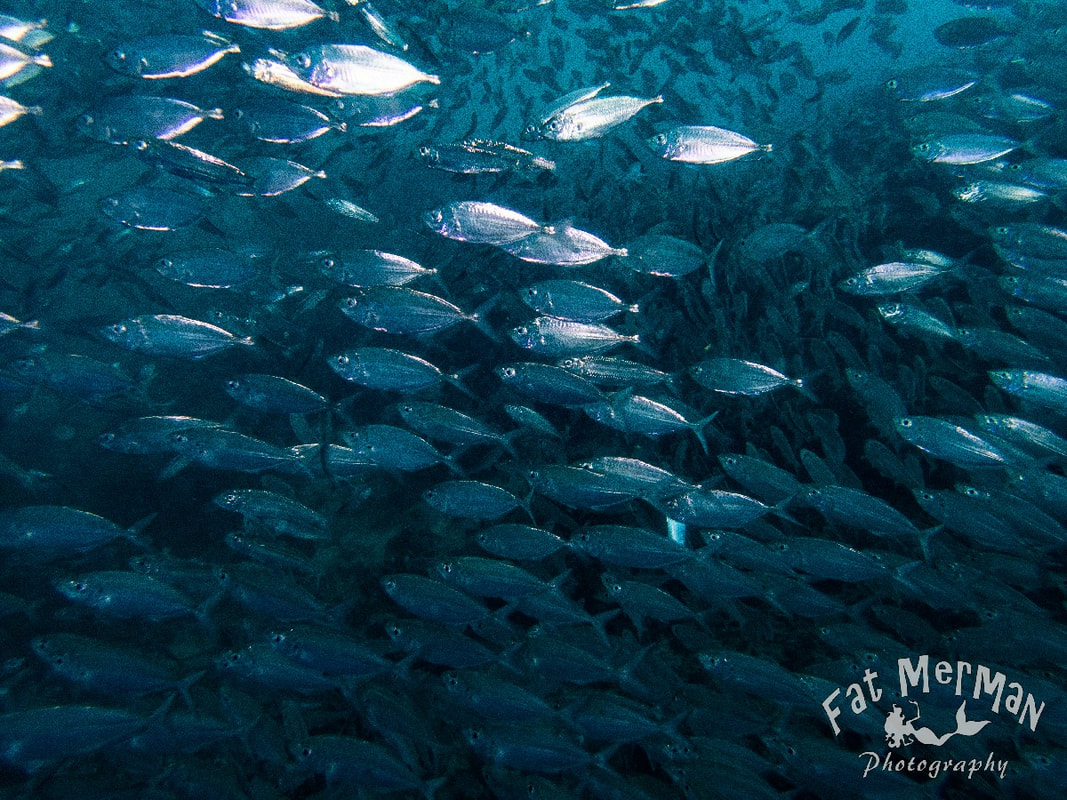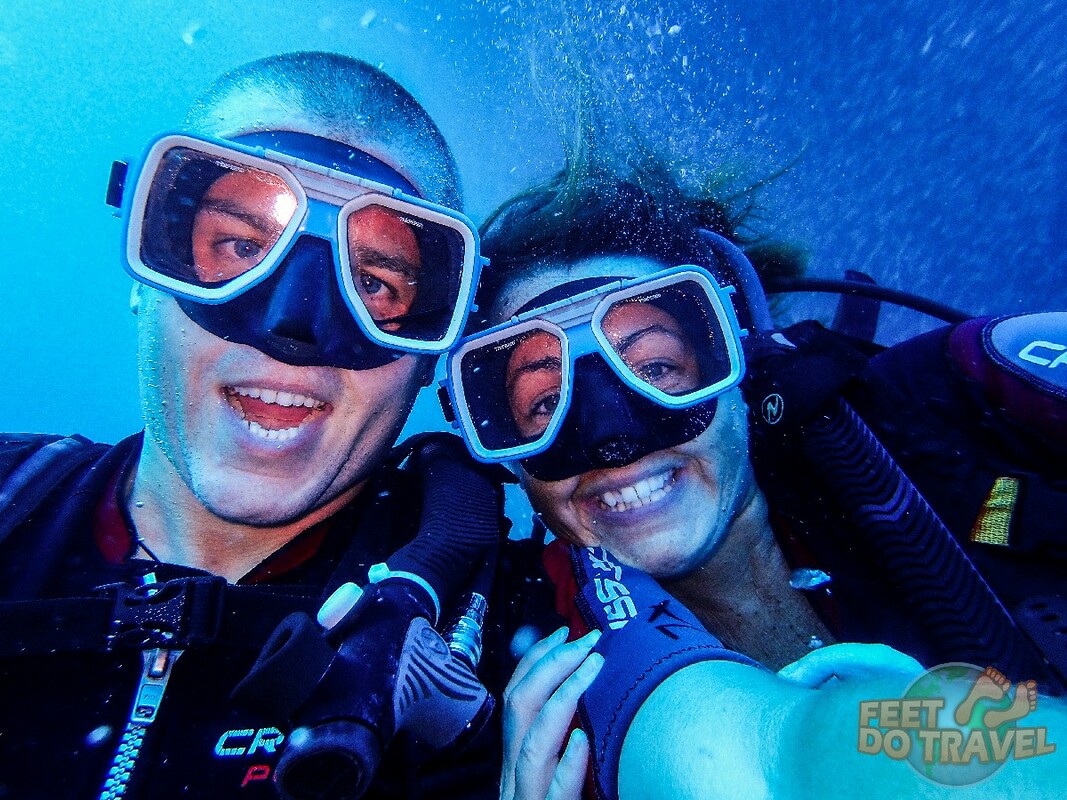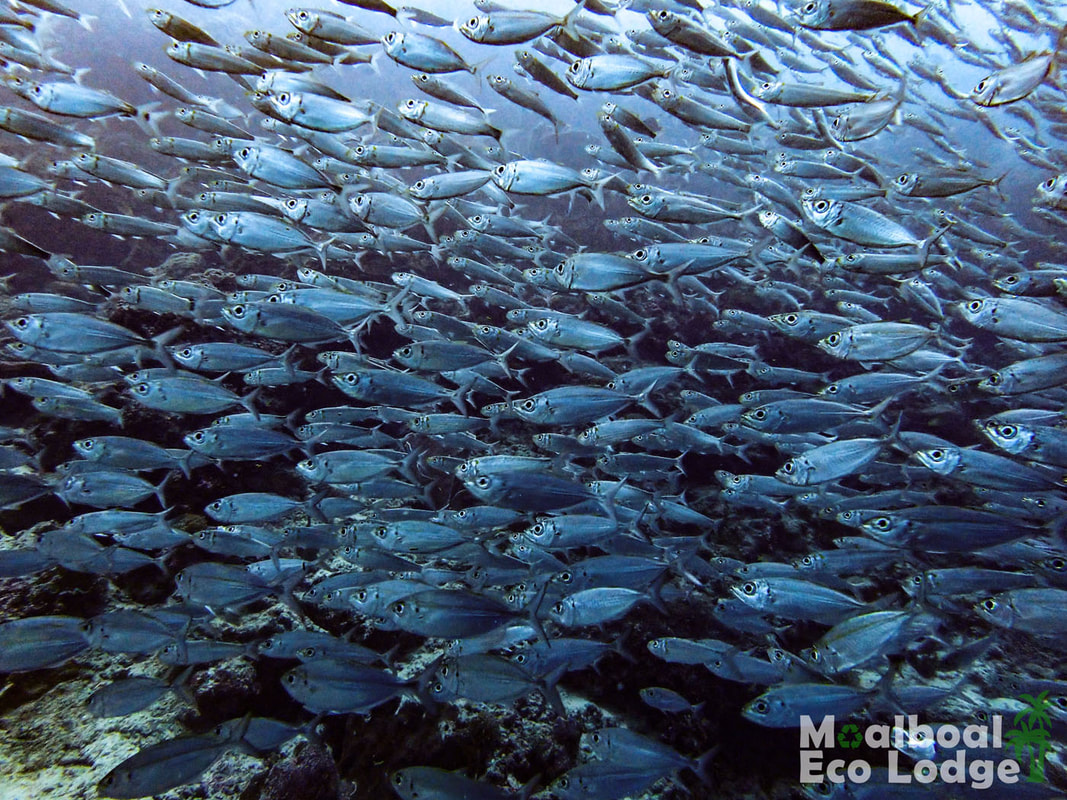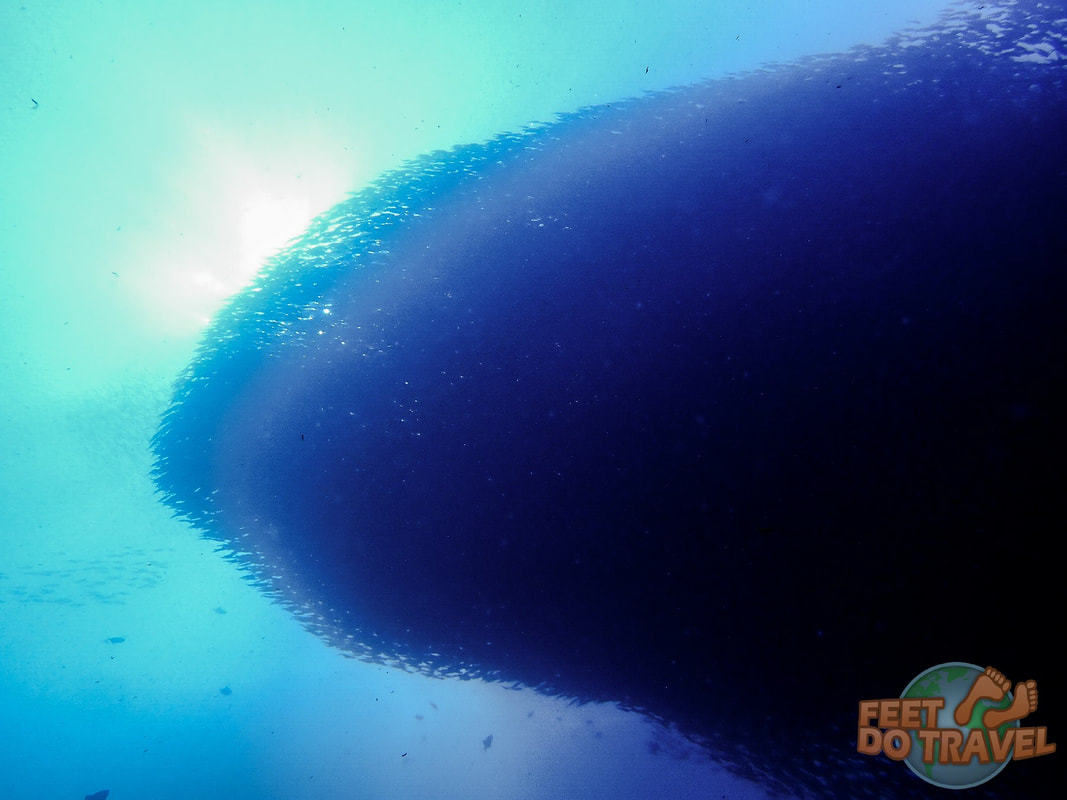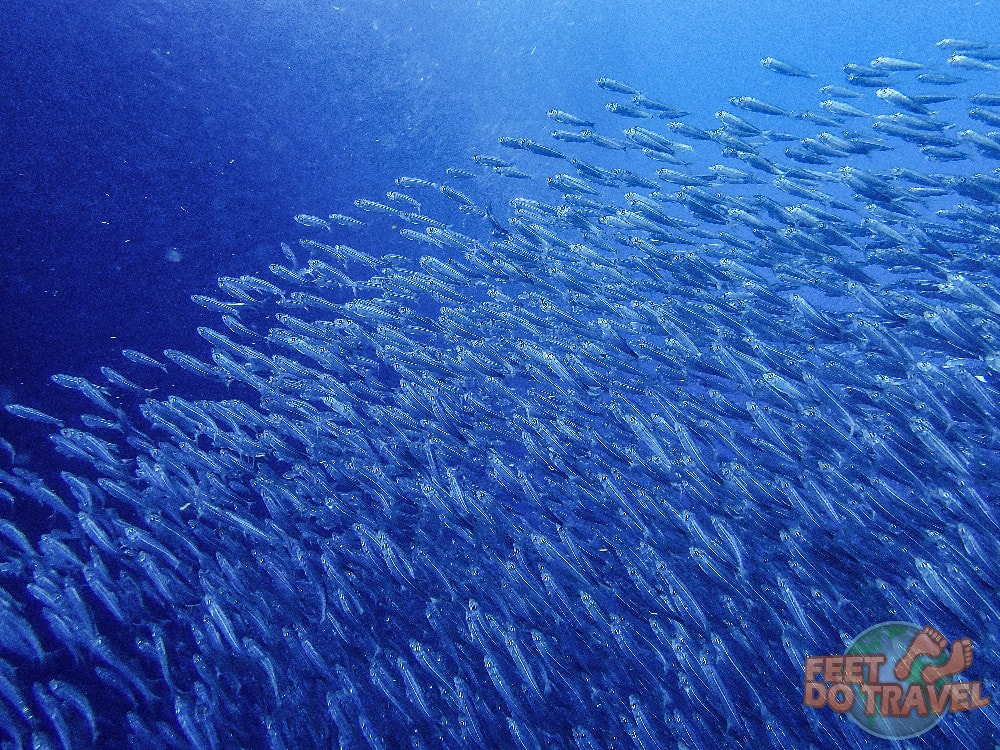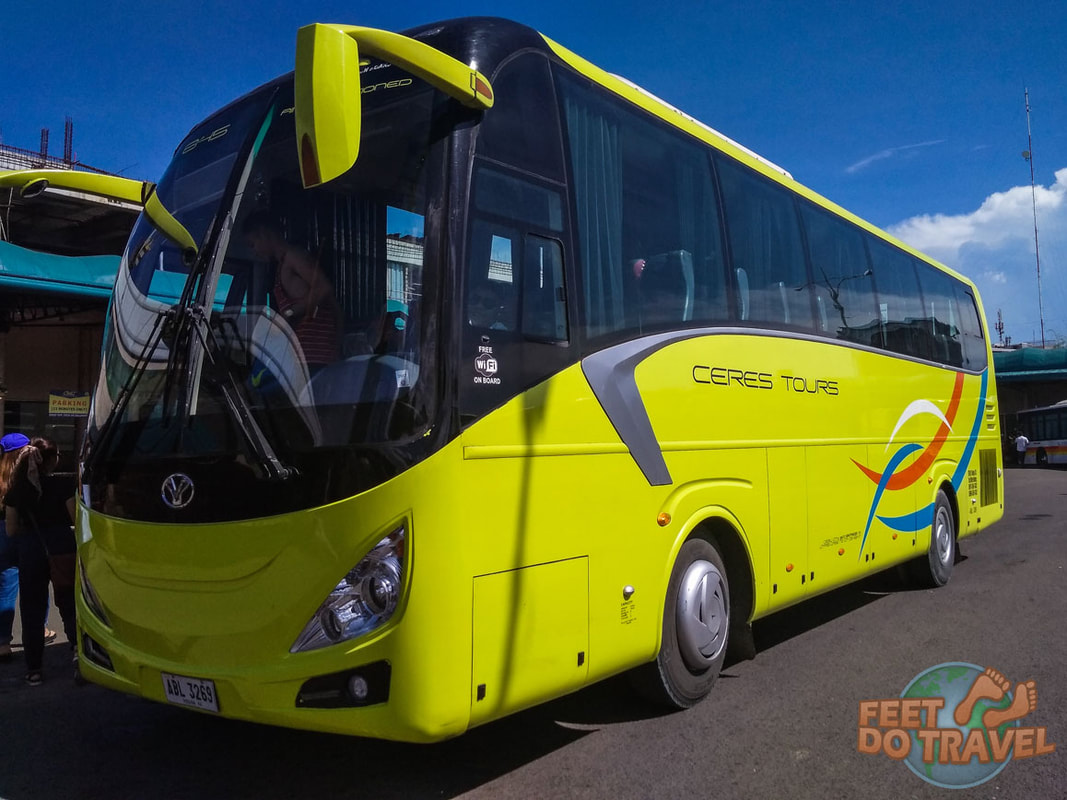The Sardine Run in Moalboal, Cebu, Philippines is better than South Africa. Whoa! Now that is a bold statement to make – what can possibly be better than seeing billions of sardines?
The (almost) guaranteed sighting of millions of sardines every single day of the year is the answer.
The Sardine Run in Moalboal is a year round natural phenomenon. It’s completely ethical - they are not fed by humans and are marine protected. As filter feeders, they stay close to the surface which means you can snorkel the sardines by walking out from the shore at Panagsama Beach.
Nothing can prepare you that first glimpse; a giant sardine ball so thick it blocks out the sun. If you are a scuba diver because you love seeing fish, Moalboal is the place to add to your bucket list.
But does it live up to the hype? Will it meet expectations? Feet Do Travel show you their experience of swimming with millions of sardines in the Philippines, at the Sardine Run Moalboal, Cebu.
The (almost) guaranteed sighting of millions of sardines every single day of the year is the answer.
The Sardine Run in Moalboal is a year round natural phenomenon. It’s completely ethical - they are not fed by humans and are marine protected. As filter feeders, they stay close to the surface which means you can snorkel the sardines by walking out from the shore at Panagsama Beach.
Nothing can prepare you that first glimpse; a giant sardine ball so thick it blocks out the sun. If you are a scuba diver because you love seeing fish, Moalboal is the place to add to your bucket list.
But does it live up to the hype? Will it meet expectations? Feet Do Travel show you their experience of swimming with millions of sardines in the Philippines, at the Sardine Run Moalboal, Cebu.
Disclaimer: This post contains some affiliate links. If you click through and make a purchase, it won't cost you any extra, the small commission we may earn will help support the FeetDoTravel community.
Sardine Run in Moalboal v South Africa Sardine Run
I made a very bold statement when I said the sardine run in Moalboal, Cebu is better than South Africa, but before you scoff, let me explain why. I will explain the South Africa Sardine Run to help you appreciate the phenomenon in Moalboal.
The South Africa sardine run is considered to be one of the greatest marine events in the world. At 7 km long, 1.5 km wide and 30 metres deep, its beauty lies in its unpredictability. You can only witness this annual event somewhere between East London to Port St John for a few weeks around May - July when the temperatures are around 19°C.
Where and when you see them depends on currents and weather conditions, generally sardines prefer cooler temperatures between 14°C and 20 °C. You could be in the water hour after hour, day after day. There is a local joke “If you want to experience the sardine run – you’ll be doing all the running!”
One thing is certain ... seeing the Sardine Run in South Africa is never guaranteed, but when nature is on your side and the conditions are right, you will witness one of the world’s most spectacular natural events.
Now throw out the rule book for Moalboal.
I made a very bold statement when I said the sardine run in Moalboal, Cebu is better than South Africa, but before you scoff, let me explain why. I will explain the South Africa Sardine Run to help you appreciate the phenomenon in Moalboal.
The South Africa sardine run is considered to be one of the greatest marine events in the world. At 7 km long, 1.5 km wide and 30 metres deep, its beauty lies in its unpredictability. You can only witness this annual event somewhere between East London to Port St John for a few weeks around May - July when the temperatures are around 19°C.
Where and when you see them depends on currents and weather conditions, generally sardines prefer cooler temperatures between 14°C and 20 °C. You could be in the water hour after hour, day after day. There is a local joke “If you want to experience the sardine run – you’ll be doing all the running!”
One thing is certain ... seeing the Sardine Run in South Africa is never guaranteed, but when nature is on your side and the conditions are right, you will witness one of the world’s most spectacular natural events.
Now throw out the rule book for Moalboal.
Just off the shore at Panagsama Beach, Moalboal, Cebu, Philippines, every single day of the year, millions of sardines make their way from the deep to feed on plankton. Sightings are about as guaranteed as you can get for nature, and it’s completely ethical - they aren’t fed by humans or rounded up in any way for tourists. It’s believed to be the second largest sardine run in the world.
OK so maybe the size of the Moalboal Sardine Run isn’t as big as South Africa but it is still a sight to behold.
The water temperature is 27°C – 30°C and the sardines are here 365 days a year. The sardines were originally on Pescador Island, a 20 minute boat trip away, but five years ago they migrated to their current location off the shore at Panagsama Beach. No one knows why but they have been seen here almost daily ever since. It’s also possible to see hunting fish such as Tuna and Jacks against the backdrop of a sloping coral reef. Swim 20-30 metres from the shore and you will find a colourful reef plunging 70 metres down into the blue abyss.
OK so maybe the size of the Moalboal Sardine Run isn’t as big as South Africa but it is still a sight to behold.
The water temperature is 27°C – 30°C and the sardines are here 365 days a year. The sardines were originally on Pescador Island, a 20 minute boat trip away, but five years ago they migrated to their current location off the shore at Panagsama Beach. No one knows why but they have been seen here almost daily ever since. It’s also possible to see hunting fish such as Tuna and Jacks against the backdrop of a sloping coral reef. Swim 20-30 metres from the shore and you will find a colourful reef plunging 70 metres down into the blue abyss.
Where is Moalboal, Cebu?
Country: Philippines
Region: Visayas
Island/Province: Cebu
Municiaplity/Town: Moalboal
Barangay: Basdiot for Panagsama Beach
The Philippines is split into three main island groups, Luzon (for Manila), Mindanao (for the Philippines highest peak, plus the Guinness World Record’s largest clam and eagle) and the Visayas, which is where Cebu is located.
Cebu is not only famous for the sardine run but for the Thresher Sharks in Malapascua. Cebu plays an important part in the region’s economy, second to Manilla.
The sardines are at Panagsama Beach, about 10-15 minutes by trike away from the main town of Moalboal.
Country: Philippines
Region: Visayas
Island/Province: Cebu
Municiaplity/Town: Moalboal
Barangay: Basdiot for Panagsama Beach
The Philippines is split into three main island groups, Luzon (for Manila), Mindanao (for the Philippines highest peak, plus the Guinness World Record’s largest clam and eagle) and the Visayas, which is where Cebu is located.
Cebu is not only famous for the sardine run but for the Thresher Sharks in Malapascua. Cebu plays an important part in the region’s economy, second to Manilla.
The sardines are at Panagsama Beach, about 10-15 minutes by trike away from the main town of Moalboal.
Our dive with millions of sardines
Our dive started nice and early, 7.30am to be exact. We walked from the shore, gently drifted with the current on the surface for a few minutes, then descended just before the sardines at a coral reef. This reef wall drops to 70 metres in some places so we also saw plenty of reef fish, and I counted seven turtles which are always a crowd pleaser.
I dive to see fish, so imagine how super excited I was when faced with millions of sardines as far as the eye could see. It’s rare I write 10/10 in my log book, the conditions have to be perfect. So along with the USS Liberty in Bali, Blue Magic and Melissa’s Garden in Raja Ampat, Sardines in Moalboal Cebu has received the coveted marking of a perfect 10.
Our dive started nice and early, 7.30am to be exact. We walked from the shore, gently drifted with the current on the surface for a few minutes, then descended just before the sardines at a coral reef. This reef wall drops to 70 metres in some places so we also saw plenty of reef fish, and I counted seven turtles which are always a crowd pleaser.
I dive to see fish, so imagine how super excited I was when faced with millions of sardines as far as the eye could see. It’s rare I write 10/10 in my log book, the conditions have to be perfect. So along with the USS Liberty in Bali, Blue Magic and Melissa’s Garden in Raja Ampat, Sardines in Moalboal Cebu has received the coveted marking of a perfect 10.
All of a sudden, there they were. A giant ball of sardines blackening my vision. My eyes grew large and my head was turning left, right, up down, it was fantastic, I couldn’t get enough.
Then I was in the middle, I had drifted into the ball and as they parted, they closed the gap around me. There I was, 360° surrounded by sardines. I let myself go, hanging upside down just relaxing into the dive and looking straight up at the beauty.
Then I was in the middle, I had drifted into the ball and as they parted, they closed the gap around me. There I was, 360° surrounded by sardines. I let myself go, hanging upside down just relaxing into the dive and looking straight up at the beauty.
The sun would sparkle, piercing the oceans surface, then the sky would turn dark. I am not exaggerating when I tell you there were so many sardine they blotted out the sunlight. As the black ball of sardines continually changed shape, sunlight continued to penetrate as a reminder it was actually daytime.
That is what I found so hypnotising; the sardines moved all the time swimming madly. The formations were spectacular like an underwater flock of birds. They would part with my bubbles, then a few Dog Tooth Tuna would start hunting them.
There were no other divers there, that was my plan! I wanted to get into the water to cherish this experience but I had an ulterior motive. Whale sharks! They had been seen on this dive site early in the morning a few days in a row, and I wanted to see one. I would look at beautiful shapes the sardines were making, then look down and out into the deep. Alas, no whale shark, but what a magnificent dive! (Additional note – on 26 February, a whale shark was again seen at the sardines).
Being surrounded by a ball of fish is a once in a lifetime experience that should not be missed, well, unless you are diving Sipadan and are surrounded by a ball of jackfish, then this is a twice in a lifetime experience!
Are the Sardines fished?
The financial income brought to Panagsama Beach means fishing with nets is strictly forbidden. The Government has worked with local fisherman and come to a long term agreement. Locals are allowed to use a hook and line in a small wooden boat, and permitted to catch enough fish to feed their family, and sell at the local market to earn a living. At sunset, you will see fishermen with small nets catching stragglers as the sardines swim down from the shore.
Sardine trivia
Sardine is actually the name of several kinds of small oily fish which belong to the herring family. Other names are pilchards and sprats, which are the main fish you will see in the Moalboal Sardine Run.
Sardines are named after Sardinia, an island in the Mediterranean where they were once abundant and easily caught. It is believed that Napoleon Bonaparte helped popularise sardines by establishing a cannery for them.
The financial income brought to Panagsama Beach means fishing with nets is strictly forbidden. The Government has worked with local fisherman and come to a long term agreement. Locals are allowed to use a hook and line in a small wooden boat, and permitted to catch enough fish to feed their family, and sell at the local market to earn a living. At sunset, you will see fishermen with small nets catching stragglers as the sardines swim down from the shore.
Sardine trivia
Sardine is actually the name of several kinds of small oily fish which belong to the herring family. Other names are pilchards and sprats, which are the main fish you will see in the Moalboal Sardine Run.
Sardines are named after Sardinia, an island in the Mediterranean where they were once abundant and easily caught. It is believed that Napoleon Bonaparte helped popularise sardines by establishing a cannery for them.
When is the best time of year to visit Moalboal, Cebu?
Moalboal, Cebu has a tropical climate with a year-round temperate of approximately 32°c. Generally there are two seasons, rainy and dry. Experts say dry season is November to May, rainy season is June to October. My experience of living in Moalboal has shown that a tropical climate means it can rain at any time, any day of the year for any length of time and the weather doesn’t adhere to “seasons”.
September/October is typhoon season, but as Cebu is outside of the typhoon belt, most of the time it’s OK.
Diving temperature in Moalboal is between 25°c -29°c. It’s recommended you wear at least a shortie regardless of the temperature to avoid jellyfish stings in these waters. The viz can be anything between 8-30 metres depending on conditions.
Do you want to take underwater photographs like us? We use an Olympus TG5 with Olympus PT-058 Underwater Housing. A popular choice amongst divers - easy to use, and you can buy additional parts such as stropes etc as you progress.
Moalboal, Cebu has a tropical climate with a year-round temperate of approximately 32°c. Generally there are two seasons, rainy and dry. Experts say dry season is November to May, rainy season is June to October. My experience of living in Moalboal has shown that a tropical climate means it can rain at any time, any day of the year for any length of time and the weather doesn’t adhere to “seasons”.
September/October is typhoon season, but as Cebu is outside of the typhoon belt, most of the time it’s OK.
Diving temperature in Moalboal is between 25°c -29°c. It’s recommended you wear at least a shortie regardless of the temperature to avoid jellyfish stings in these waters. The viz can be anything between 8-30 metres depending on conditions.
Do you want to take underwater photographs like us? We use an Olympus TG5 with Olympus PT-058 Underwater Housing. A popular choice amongst divers - easy to use, and you can buy additional parts such as stropes etc as you progress.
|
The underwater housing without the camera - to show you how it looks
|
Who should you dive with?
There are many dive centres to choose from and most can be found along Panagsama Beach, however from personal experience and from living in the dive community for a few months, these are my personal recommendations. Diving here is more than the Sardine Run, Pescador Island (a protected marine park with an underwater open top cave called "the Cathedral") and Umbrella are also fantastic dive sites.
Cebu Dive Centre – The cheapest, one of the busiest on the island (5/5 review on Trip Advisor and rated Number 1). I highly advise you book in advance so as not to be disappointed. Cameron the manager runs an efficient dive practice. It has a small bar on site for an after-dive beer and social sunset spot. Walk in off the shore to the Sardines.
Savedra – A PADI IDC Centre and highly regarded (No. 6 on Trip Advisor). They are located about 50 metres from Cebu Dive Centre, and their house reef is the Sardines.
Blue Abyss – I have personally dived at this centre which is a 5-10 minute walk along the beachfront from the main strip (No. 7 on Trip Advisor). They have a large, spacious dive centre and a good size boat. They have lovely accommodation and fantastic restaurant just down from the dive centre, and you can arrange stay/dive packages.
There are many dive centres to choose from and most can be found along Panagsama Beach, however from personal experience and from living in the dive community for a few months, these are my personal recommendations. Diving here is more than the Sardine Run, Pescador Island (a protected marine park with an underwater open top cave called "the Cathedral") and Umbrella are also fantastic dive sites.
Cebu Dive Centre – The cheapest, one of the busiest on the island (5/5 review on Trip Advisor and rated Number 1). I highly advise you book in advance so as not to be disappointed. Cameron the manager runs an efficient dive practice. It has a small bar on site for an after-dive beer and social sunset spot. Walk in off the shore to the Sardines.
Savedra – A PADI IDC Centre and highly regarded (No. 6 on Trip Advisor). They are located about 50 metres from Cebu Dive Centre, and their house reef is the Sardines.
Blue Abyss – I have personally dived at this centre which is a 5-10 minute walk along the beachfront from the main strip (No. 7 on Trip Advisor). They have a large, spacious dive centre and a good size boat. They have lovely accommodation and fantastic restaurant just down from the dive centre, and you can arrange stay/dive packages.
As a Diver, if you care about coral reefs, please use REEF SAFE SUN CREAM
Omuci DO NOT contain Palm Oil; Green People source SUSTAINABLE Palm Oil
Wondering what to pack for your next trip? Let us help you with the essentials in our Ultimate Packing List for Worldwide Travel (tried and tested!)
Where to stay in Moalboal
We stayed in Moalboal Eco Lodge and highly recommend it. Nestled amongst palm trees half way between Moalboal town and Panagsama, it's the perfect location. Close to amenities and restaurants, yet far enough away to have a quiet night's sleep, we can't think of a better place for you to enjoy Cebu!
We stayed in Moalboal Eco Lodge and highly recommend it. Nestled amongst palm trees half way between Moalboal town and Panagsama, it's the perfect location. Close to amenities and restaurants, yet far enough away to have a quiet night's sleep, we can't think of a better place for you to enjoy Cebu!
How to get to Moalboal and Panagsama Beach
By Air: Mactan-Cubu International Airport has daily domestic and international flights.
We have flown to Mactan-Cebu from Singapore and Kuala Lumpur (Malaysia) which means you can easily twin a visit to Cebu and another Asian City.
Cebu is long and narrow and there are no main highways, it can therefore take a while to travel around depending on the time of day and traffic, so you need to bear this in mind.
Moalboal is situated south of Cebu City (3-4 hours) and north of Bato if you are coming over from Negros (1.5-2 hours).
By Private Transfer from the Airport – From Mactan-Cebu Airport/Cebu City you can grab a private car to take you door to door. This is the easiest option but the most expensive.
Cost: P2,500 – 3,000.
If you are on a budget:
1. First you need to get from Mactan-Cebu Airport to Cebu City South Bus Terminal
By Bus from Mactan-Cebu Airport – Buses run every 20-30 minutes between 7am-9.30pm. Take myBus to the South Bus Terminal. Cost: P25.
By Taxi from Mactan-Cebu Airport - If you don’t want to take a bus to the bus station, or if you land outside of the above hours, take a WHITE TAXI (the yellow charge more) to Cebu City, Cebu South Bus Terminal (20-30 mins). Cost: P200-300.
2. From Cebu City South Bus Terminal to Moalboal - Look for the yellow Ceres Bus Line (Stand C5 and C6) for BATO via BARILI (Air Con/Ordinary). Buses depart every 30 minutes and it will take between 2.5 hours to 4 hours depending on traffic. Sometimes they make a toilet stop. Cost: One way ticket on air con bus = P140 (£2)
3. From Moalboal to Panagsama. - Get off the bus at 7/11 (a few minutes past McDonalds/Gaisano Grand Mall. If you are diving the sardines you will be heading for Panagsama Beach, look out for the brown tourist sign (NB – Tell the bus driver you want Panagsama and they will let you know). Grab a trike to your accommodation, it will take about 10-20 minutes depending on where you stay. It can be noisy and bumpy, but this is the local way so soak it up and experience Philippine culture.
Cost: P100 – 150 (depending on how tired you are and your haggling skills)
By Air: Mactan-Cubu International Airport has daily domestic and international flights.
We have flown to Mactan-Cebu from Singapore and Kuala Lumpur (Malaysia) which means you can easily twin a visit to Cebu and another Asian City.
Cebu is long and narrow and there are no main highways, it can therefore take a while to travel around depending on the time of day and traffic, so you need to bear this in mind.
Moalboal is situated south of Cebu City (3-4 hours) and north of Bato if you are coming over from Negros (1.5-2 hours).
By Private Transfer from the Airport – From Mactan-Cebu Airport/Cebu City you can grab a private car to take you door to door. This is the easiest option but the most expensive.
Cost: P2,500 – 3,000.
If you are on a budget:
1. First you need to get from Mactan-Cebu Airport to Cebu City South Bus Terminal
By Bus from Mactan-Cebu Airport – Buses run every 20-30 minutes between 7am-9.30pm. Take myBus to the South Bus Terminal. Cost: P25.
By Taxi from Mactan-Cebu Airport - If you don’t want to take a bus to the bus station, or if you land outside of the above hours, take a WHITE TAXI (the yellow charge more) to Cebu City, Cebu South Bus Terminal (20-30 mins). Cost: P200-300.
2. From Cebu City South Bus Terminal to Moalboal - Look for the yellow Ceres Bus Line (Stand C5 and C6) for BATO via BARILI (Air Con/Ordinary). Buses depart every 30 minutes and it will take between 2.5 hours to 4 hours depending on traffic. Sometimes they make a toilet stop. Cost: One way ticket on air con bus = P140 (£2)
3. From Moalboal to Panagsama. - Get off the bus at 7/11 (a few minutes past McDonalds/Gaisano Grand Mall. If you are diving the sardines you will be heading for Panagsama Beach, look out for the brown tourist sign (NB – Tell the bus driver you want Panagsama and they will let you know). Grab a trike to your accommodation, it will take about 10-20 minutes depending on where you stay. It can be noisy and bumpy, but this is the local way so soak it up and experience Philippine culture.
Cost: P100 – 150 (depending on how tired you are and your haggling skills)
How to get around Panagsama Beach, Moalboal and Cebu
Scooter
If you want to explore and see most of the things to do in Moalboal, I would recommend hiring a scooter. At P250-300 per day it’s the cheapest most convenient mode of transport which can be hired everywhere.
NB. ALWAYS wear a helmet. A study by the World Health Organisation showed that over 90% of motorcycle deaths didn’t wear helmets. Around 53% of all traffic accidents in the Philippines are motorcyclists and their passengers. It’s better to arrive at your destination with helmet hair than not arrive at all.
The main roads are excellent, however around Panagsama they are rocky and bumpy. If you haven’t driven in Asia before, at first glance the system may appear chaotic, but the system works exceptionally well. Everyone is respectful and traffic naturally gives way to one another at junctions, people overtaking give you a wide berth if you wish to travel slowly.
Note: The horn is used as a way of polite communication – to let someone else know you are near, behind or overtaking them – so honk that horn and scooter like a local.
Local transport
There are plenty of local transport options; jump on the back of a motorbike (habal-habal), a trike (motorbike with side car), jeepney (US style bus with crowded seating, it’s how the locals travel) and the Ceres Line bus which runs regularly along the main highway. Alternatively, you will find plenty of places offering trips to the popular sights.
Want to learn more about the Philippine Jeepneys? Check out Off the Wall Street Art in Cebu - Unusual Expression of Art in the Philippines
Philippines Travel and Visa information
- Language – English is widely spoken to an excellent standard. In this region of the Philippines, the official language is Visayan.
- Currency – Philippine Peso, shown as either P or PHP. £1 = P70
- Plugs & Electricity – 2-pin plugs (same as US/Canada/China/Japan, flat parallel, also known as Type A). Some places are also Type B (same as UK) and Type C (known as the “Euro” plug) Standard voltage is 220 V and the standard frequency is 60 Hz.
- Wi-Fi – Available everywhere; scuba diving centres, hotels, bars and restaurants
- ATM’s – There is an ATM in Evie’s at Panagsama Beach. In Moalboal there is another inside the Three-Sixty Pharmacy. NB. There is a P10,000 withdrawal limit per transaction with a mandatory country-wide fee of P250
- Driving – Right hand drive
- Visa - A 29 day visa is given at the time of arrival. You can easily extend at a local immigration office for another 29 days, the nearest and quickest is on the neighbouring island of Negros in Dumagete City (you will need to give a Negros address, just pick any dive centre or hotel). You can extend in Cebu City but it’s busier and will take longer.
- Airport – Mactan-Cebu International Airport in Cebu City is the nearest domestic and international airport. Cebu Pacific and Philippine Airlines fly here. NB. Departure tax of P850 is payable for all international departures at all airports.
- Religion - Catholic
Check out these related links for more Scuba Diving Inspiration:
Ethical Swim with Whale Sharks in Leyte, Philippines
Diving in Dauin, Negros: Muck Diving in the Philippines
Diving in Borneo - Always Awesome
Diving the World's Number 1 Dive Site - Sipadan
Scuba Diving the Gili Islands
Manta Madness
Diving Raja Ampat
Lembeh - A Magical Muck Diving Experience
USS Liberty in Bali - Highly Wreck-Ommended
Nusa Penida: Diving with Mola Mola, the Ocean Sunfish
Disclaimer: This post contains some affiliate links. If you click through and make a purchase, it won't cost you any extra, the small commission we may earn will help support the FeetDoTravel community.

Do you want to be a better traveller and reduce your single use plastic? Hop over to our Travel Shop for inspiration. Refillable water bottles, reusable cutlery, bamboo straws, bamboo toothbrush, toothpaste power, shampoo bars and many more.
Do you want to be a better traveller and reduce your single use plastic? Hop over to our Travel Shop for inspiration. Refillable water bottles, reusable cutlery, bamboo straws, bamboo toothbrush, toothpaste power, shampoo bars and many more.

Book your Moalboal, Cebu, Philippines, Asia, any worldwide holiday, or weekend break hotel through our website. We always use Booking.com. Visit our Hotel Booking Page and search as normal. (If you are on a mobile phone, turn the device horizontally, the “search” button will be bottom right).
If you are travelling around Asia, we recommend you check bus, boat and train schedules ahead of time with 12Go Asia. You can also book your tickets in advance online (as we did) to save time and hassle.
Pin this post for future reference!



